Quantitative Calculation of the Most Efficient LED Light Combinations at Specific Growth Stages for Basil Indoor Horticulture: Modeling through Design of Experiments
Abstract
Featured Application
Abstract
1. Introduction
Main Contributions of This Work
2. Materials and Methods
2.1. Experimental Growth Test
2.2. Experimental Plan
2.3. Characterizations
2.4. Statistical Analysis
3. Results and Discussion
3.1. General Observation of the Experimental Tests
3.2. Analysis of Variance of the Responses
3.3. Quantitative Calculation of the Mathematical Models
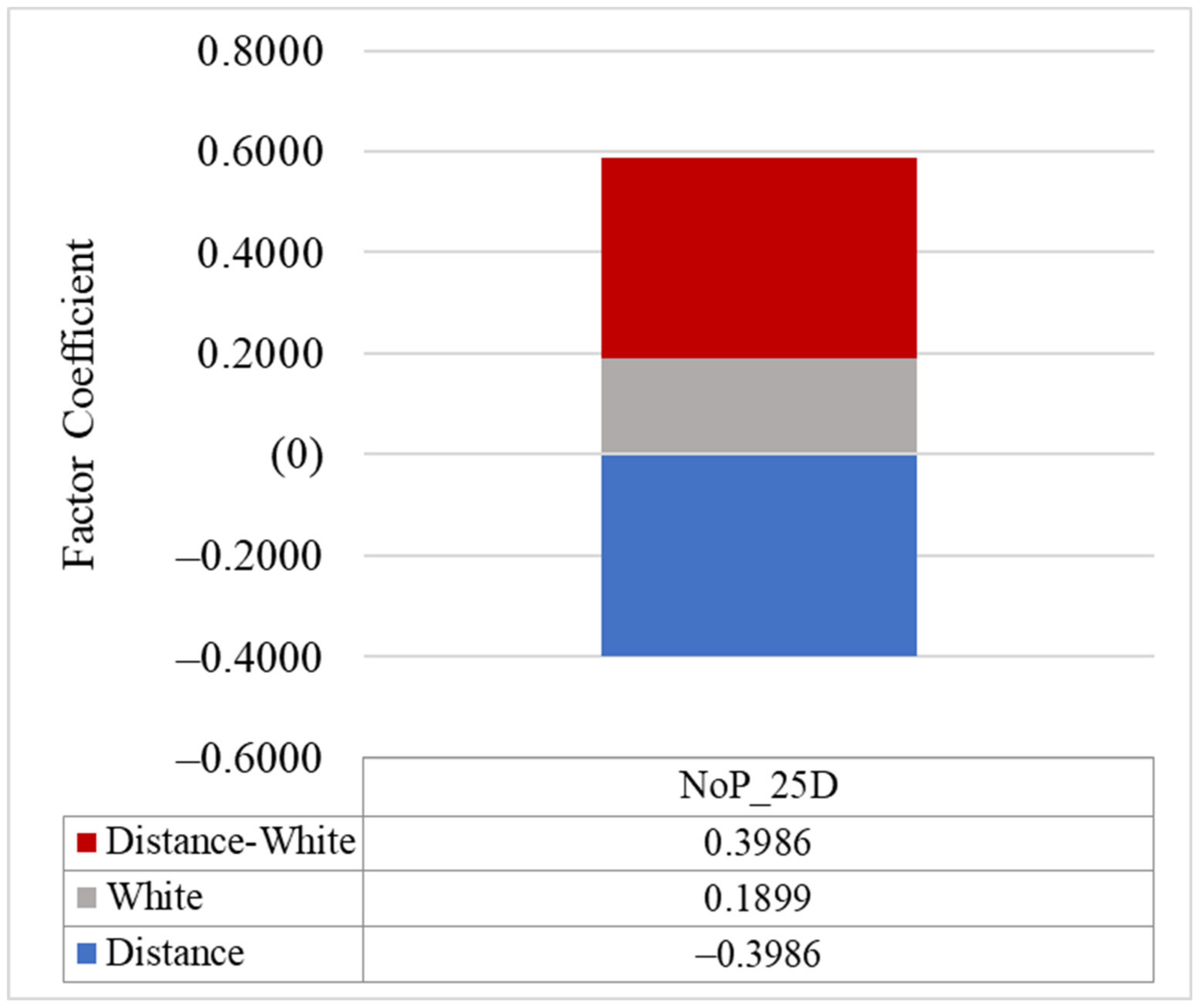
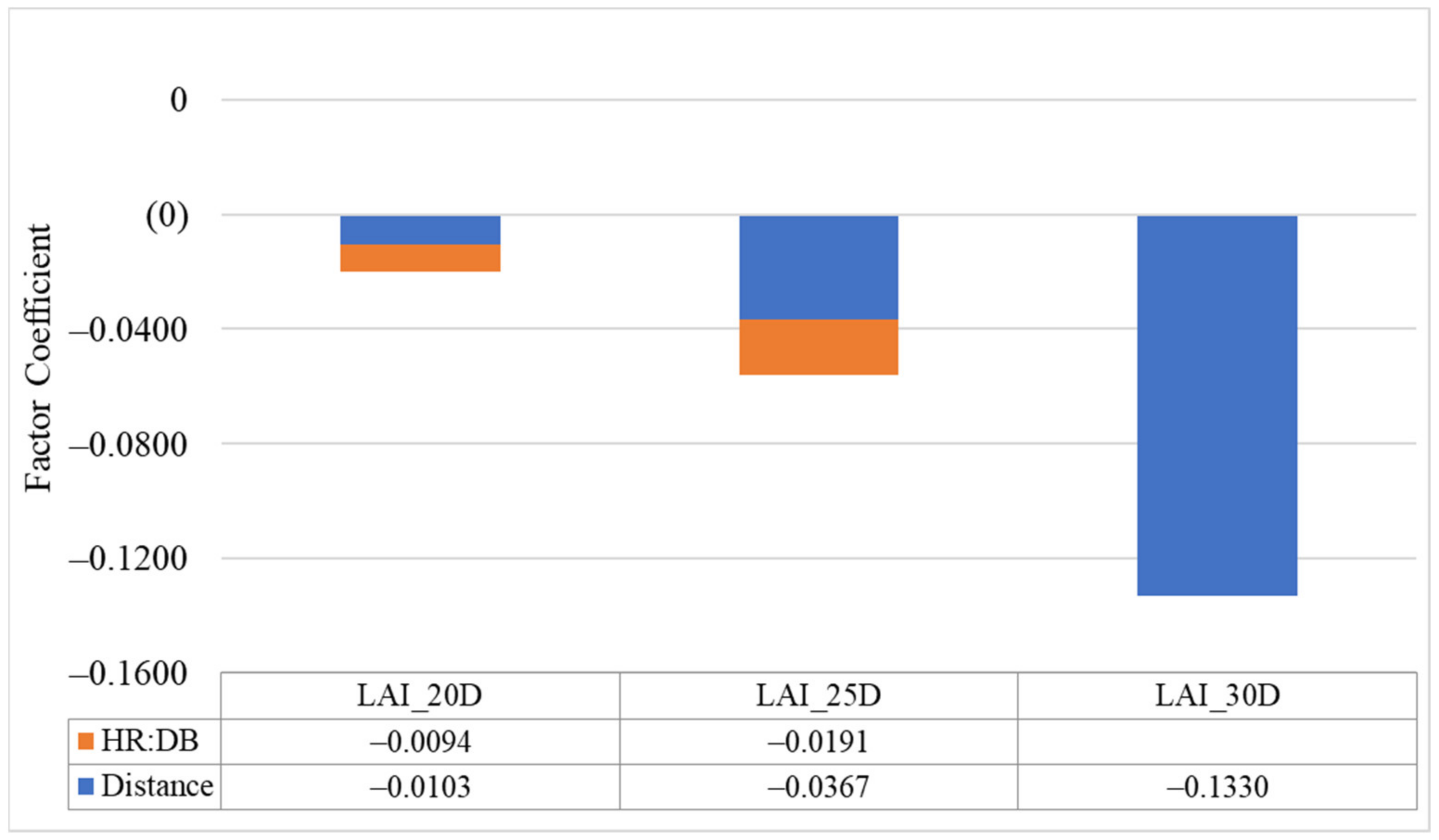
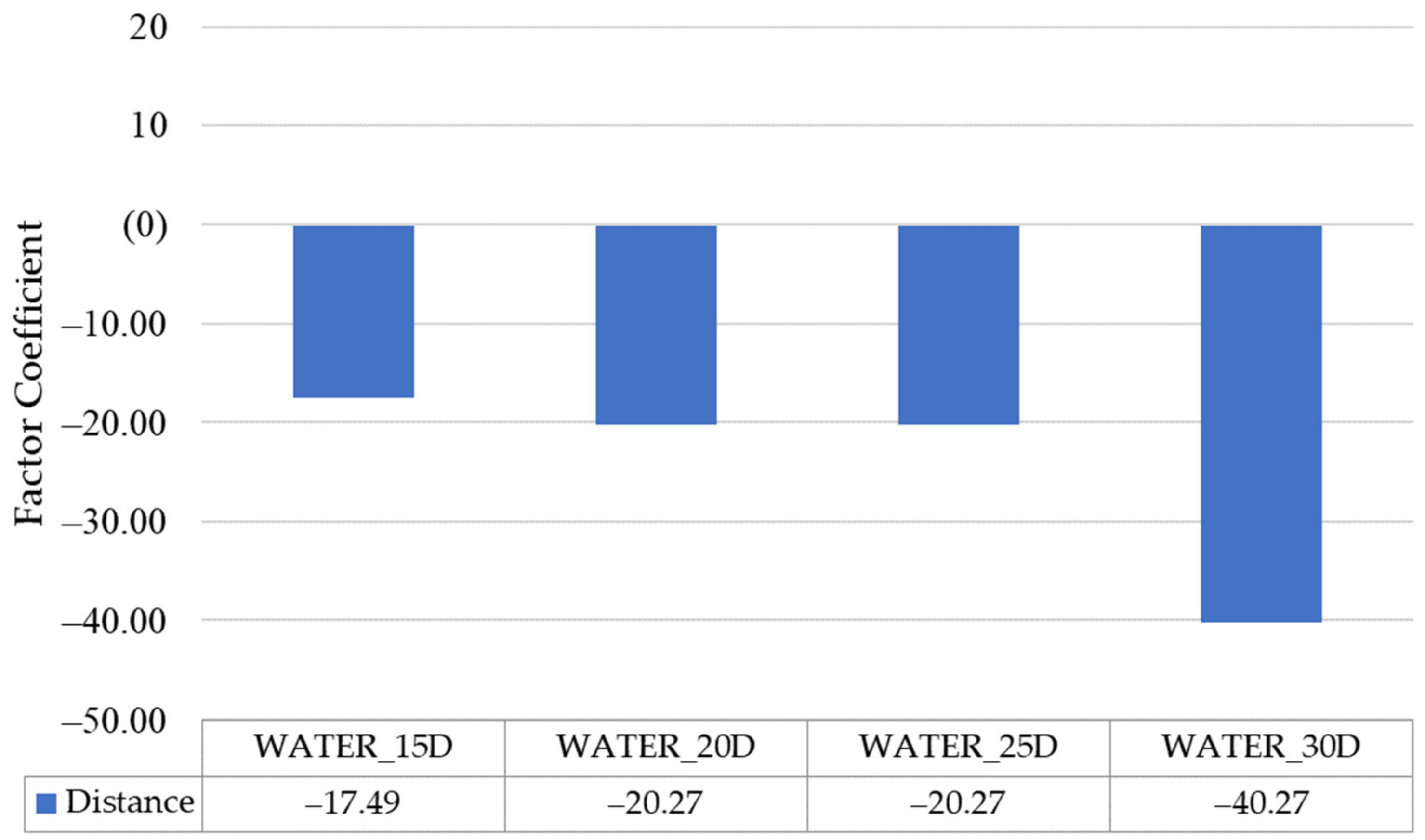
3.4. Mathematical Models Validation
3.5. Discussion
4. Conclusions
Author Contributions
Funding
Institutional Review Board Statement
Informed Consent Statement
Data Availability Statement
Acknowledgments
Conflicts of Interest
References
- Food and Agriculture Organization of the United Nations. World Food and Agriculture—Statistical Yearbook 2021; FAO: Rome, Italy, 2021. [Google Scholar]
- Crippa, M.; Solazzo, E.; Guizzardi, D.; Monforti-Ferrario, F.; Tubiello, F.N.; Leip, A. Food Systems Are Responsible for a Third of Global Anthropogenic GHG Emissions. Nat. Food 2021, 2, 198–209. [Google Scholar] [CrossRef]
- Guo, H.; Xia, Y.; Jin, J.; Pan, C. The Impact of Climate Change on the Efficiency of Agricultural Production in the World’s Main Agricultural Regions. Environ. Impact Assess. Rev. 2022, 97, 106891. [Google Scholar] [CrossRef]
- Spinoni, J.; Barbosa, P.; Cherlet, M.; Forzieri, G.; McCormick, N.; Naumann, G.; Vogt, J.V.; Dosio, A. How Will the Progressive Global Increase of Arid Areas Affect Population and Land-Use in the 21st Century? Glob. Planet. Chang. 2021, 205, 103597. [Google Scholar] [CrossRef]
- Zougmoré, R.B.; Läderach, P.; Campbell, B.M. Transforming Food Systems in Africa under Climate Change Pressure: Role of Climate-Smart Agriculture. Sustainability 2021, 13, 4305. [Google Scholar] [CrossRef]
- Goldstein, B.; Hauschild, M.; Fernández, J.; Birkved, M. Urban versus Conventional Agriculture, Taxonomy of Resource Profiles: A Review. Agron. Sustain. Dev. 2016, 36, 9. [Google Scholar] [CrossRef]
- O’Sullivan, C.A.; Bonnett, G.D.; McIntyre, C.L.; Hochman, Z.; Wasson, A.P. Strategies to Improve the Productivity, Product Diversity and Profitability of Urban Agriculture. Agric. Syst. 2019, 174, 133–144. [Google Scholar] [CrossRef]
- Avgoustaki, D.D.; Li, J.; Xydis, G. Basil Plants Grown under Intermittent Light Stress in a Small-Scale Indoor Environment: Introducing Energy Demand Reduction Intelligent Technologies. Food Control 2020, 118, 107389. [Google Scholar] [CrossRef]
- Kikuchi, Y.; Kanematsu, Y.; Okubo, T. Life Cycle Design of Indoor Hydroponic Horticulture Considering Energy-Water-Food Nexus. Comput. Aided Chem. Eng. 2019, 46, 1585–1590. [Google Scholar] [CrossRef]
- Kozai, T.; Fujiwara, K.; Runkle, E.S. LED Lighting for Urban Agriculture; Springer: Singapore, 2016; ISBN 9789811018480. [Google Scholar]
- Dutta Gupta, S. Light Emitting Diodes for Agriculture: Smart Lighting; Springer: Singapore, 2017; ISBN 9789811058073. [Google Scholar]
- Serôdio, J.; Schmidt, W.; Frommlet, J.C.; Christa, G.; Nitschke, M.R. An LED-Based Multi-Actinic Illumination System for the High Throughput Study of Photosynthetic Light Responses. PeerJ 2018, 6, e5589. [Google Scholar] [CrossRef]
- Xydis, G.A.; Liaros, S.; Avgoustaki, D.D. Small Scale Plant Factories with Artificial Lighting and Wind Energy Microgeneration: A Multiple Revenue Stream Approach. J. Clean. Prod. 2020, 255, 120227. [Google Scholar] [CrossRef]
- Bontsema, J.; van Henten, E.J.; Gieling, T.H.; Swinkels, G.L.A.M. The Effect of Sensor Errors on Production and Energy Consumption in Greenhouse Horticulture. Comput. Electron. Agric. 2011, 79, 63–66. [Google Scholar] [CrossRef]
- Massa, G.D.; Kim, H.-H.; Wheeler, R.M.; Mitchell, C.A. Plant Productivity in Response to LED Lighting. HortScience 2008, 43, 1951–1956. [Google Scholar] [CrossRef]
- Wang, L.; Iddio, E.; Ewers, B. Introductory Overview: Evapotranspiration (ET) Models for Controlled Environment Agriculture (CEA). Comput. Electron. Agric. 2021, 190, 106447. [Google Scholar] [CrossRef]
- Wang, L.; Iddio, E. Energy Performance Evaluation and Modeling for an Indoor Farming Facility. Sustain. Energy Technol. Assess. 2022, 52, 102240. [Google Scholar] [CrossRef]
- Bantis, F.; Smirnakou, S.; Ouzounis, T.; Koukounaras, A.; Ntagkas, N.; Radoglou, K. Current Status and Recent Achievements in the Field of Horticulture with the Use of Light-Emitting Diodes (LEDs). Sci. Hortic. 2018, 235, 437–451. [Google Scholar] [CrossRef]
- Moher, M.; Llewellyn, D.; Jones, M.; Zheng, Y. Light Intensity Can Be Used to Modify the Growth and Morphological Characteristics of Cannabis during the Vegetative Stage of Indoor Production. Ind. Crops Prod. 2022, 183, 114909. [Google Scholar] [CrossRef]
- Sipos, L.; Balázs, L.; Székely, G.; Jung, A.; Sárosi, S.; Radácsi, P.; Csambalik, L. Optimization of Basil (Ocimum basilicum L.) Production in LED Light Environments—A Review. Sci. Hortic. 2021, 289, 110486. [Google Scholar] [CrossRef]
- Sipos, L.; Boros, I.F.; Csambalik, L.; Székely, G.; Jung, A.; Balázs, L. Horticultural Lighting System Optimalization: A Review. Sci. Hortic. 2020, 273, 109631. [Google Scholar] [CrossRef]
- Ciriello, M.; Kyriacou, M.C.; de Pascale, S.; Rouphael, Y. An Appraisal of Critical Factors Configuring the Composition of Basil in Minerals, Bioactive Secondary Metabolites, Micronutrients and Volatile Aromatic Compounds. J. Food Compos. Anal. 2022, 111, 104582. [Google Scholar] [CrossRef]
- Pennisi, G.; Pistillo, A.; Orsini, F.; Cellini, A.; Spinelli, F.; Nicola, S.; Fernandez, J.A.; Crepaldi, A.; Gianquinto, G.; Marcelis, L.F.M. Optimal Light Intensity for Sustainable Water and Energy Use in Indoor Cultivation of Lettuce and Basil under Red and Blue LEDs. Sci. Hortic. 2020, 272, 109508. [Google Scholar] [CrossRef]
- Piovene, C.; Orsini, F.; Bosi, S.; Sanoubar, R.; Bregola, V.; Dinelli, G.; Gianquinto, G. Optimal Red: Blue Ratio in Led Lighting for Nutraceutical Indoor Horticulture. Sci. Hortic. 2015, 193, 202–208. [Google Scholar] [CrossRef]
- Jensen, N.B.; Clausen, M.R.; Kjaer, K.H. Spectral Quality of Supplemental LED Grow Light Permanently Alters Stomatal Functioning and Chilling Tolerance in Basil (Ocimum basilicum L.). Sci. Hortic. 2018, 227, 38–47. [Google Scholar] [CrossRef]
- Barbi, S.; Barbieri, F.; Bertacchini, A.; Montorsi, M. Statistical Optimization of a Hyper Red, Deep Blue, and White Leds Light Combination for Controlled Basil Horticulture. Appl. Sci. 2021, 11, 9279. [Google Scholar] [CrossRef]
- Demir, K.; Sarıkamış, G.; Çakırer Seyrek, G. Effect of LED Lights on the Growth, Nutritional Quality and Glucosinolate Content of Broccoli, Cabbage and Radish Microgreens. Food Chem. 2023, 401, 134088. [Google Scholar] [CrossRef]
- He, W.; Pu, M.; Li, J.; Xu, Z.G.; Gan, L. Potato Tuber Growth and Yield Under Red and Blue LEDs in Plant Factories. J. Plant Growth Regul. 2022, 41, 40–51. [Google Scholar] [CrossRef]
- Sutulienė, R.; Laužikė, K.; Pukas, T.; Samuolienė, G. Effect of Light Intensity on the Growth and Antioxidant Activity of Sweet Basil and Lettuce. Plants 2022, 11, 1709. [Google Scholar] [CrossRef] [PubMed]
- Barbi, S.; Barbieri, F.; Bertacchini, A.; Barbieri, L.; Montorsi, M. Effects of Different LED Light Recipes and NPK Fertilizers on Basil Cultivation for Automated and Integrated Horticulture Methods. Appl. Sci. 2021, 11, 2497. [Google Scholar] [CrossRef]
- Intelligent Led Solutions Petunia Led Modules. Available online: https://i-led.co.uk/PDFs/Kits/12Multi-OslonSSL-PetuniaColourV3.pdf (accessed on 28 January 2021).
- OSRAM LH CP7P 660 Nm Hyper Red LED. Available online: https://www.osram.com/ecat/OSLON®SSL80LHCP7P/com/en/class_pim_web_catalog_103489/prd_pim_device_2402508/ (accessed on 20 December 2022).
- OSRAM LD CQ7P 451 Nm Deep Blue LED. Available online: https://www.osram.com/ecat/OSLON®SSL80LDCQ7P/com/en/class_pim_web_catalog_103489/prd_pim_device_2402502/ (accessed on 20 December 2022).
- OSRAM LCW CQDP.EC 3000 K Warm White LED. Available online: https://media.digikey.com/PDF/Data%20Sheets/Osram%20PDFs/LCW_CQDP.EC.pdf (accessed on 20 December 2022).
- LEDiL LEDiL C12528 PETUNIA Lens. Available online: https://www.ledil.com/product-card/?product=C12528_PETUNIA# (accessed on 20 December 2022).
- Montgomery, D.C. Design and Analysis of Experiments Eighth Edition; Wiley: Hoboken, NJ, USA, 2012; Volume 2, ISBN 9781118146927. [Google Scholar]
- Bréda, N.J.J. Leaf Area Index. Encyclopedia of Ecology, Five-Volume Set; Academic Press: Cambridge, MA, USA, 2008; pp. 2148–2154. [Google Scholar] [CrossRef]
- Folta, K.M.; Maruhnich, S.A. Green Light: A Signal to Slow down or Stop. J. Exp. Bot. 2007, 58, 3099–3111. [Google Scholar] [CrossRef]
- Xiaoying, L.; Shirong, G.; Zhigang, X.; Xuelei, J.; Tezuka, T. Regulation of Chloroplast Ultrastructure, Cross-section Anatomy of Leaves, and Morphology of Stomata of Cherry Tomato by Different Light Irradiations of Light-emitting Diodes. Hortscience 2011, 46–217. [Google Scholar] [CrossRef]
- Kondratieva, V.V.; Voronkova, T.V.; Semenova, M.V.; Olekhnovich, L.S.; Shelepova, O.V. Effect of LEDs on the Growth and Physiological Responses of Sweet Basil (Ocimum basilicum L.). In Proceedings of the IOP Conference Series: Earth and Environmental Science; Institute of Physics, Smolensk, Russia, 23–27 January 2022; Volume 1045. [Google Scholar]
- Modarelli, G.C.; Paradiso, R.; Arena, C.; de Pascale, S.; van Labeke, M.C. High Light Intensity from Blue-Red LEDs Enhance Photosynthetic Performance, Plant Growth, and Optical Properties of Red Lettuce in Controlled Environment. Horticulturae 2022, 8, 114. [Google Scholar] [CrossRef]
- Avgoustaki, D.D.; Xydis, G. Energy Cost Reduction by Shifting Electricity Demand in Indoor Vertical Farms with Artificial Lighting. Biosyst. Eng. 2021, 211, 219–229. [Google Scholar] [CrossRef]
- Kowalczyk, K.; Olewnicki, D.; Mirgos, M.; Gajc-Wolska, J. Comparison of Selected Costs in Greenhouse Cucumber Production with LED and HPS Supplemental Assimilation Lighting. Agronomy 2020, 10, 1342. [Google Scholar] [CrossRef]
- Lin, K.H.; Huang, M.Y.; Hsu, M.H. Morphological and Physiological Response in Green and Purple Basil Plants (Ocimum basilicum) under Different Proportions of Red, Green, and Blue LED Lightings. Sci. Hortic. 2021, 275, 109677. [Google Scholar] [CrossRef]

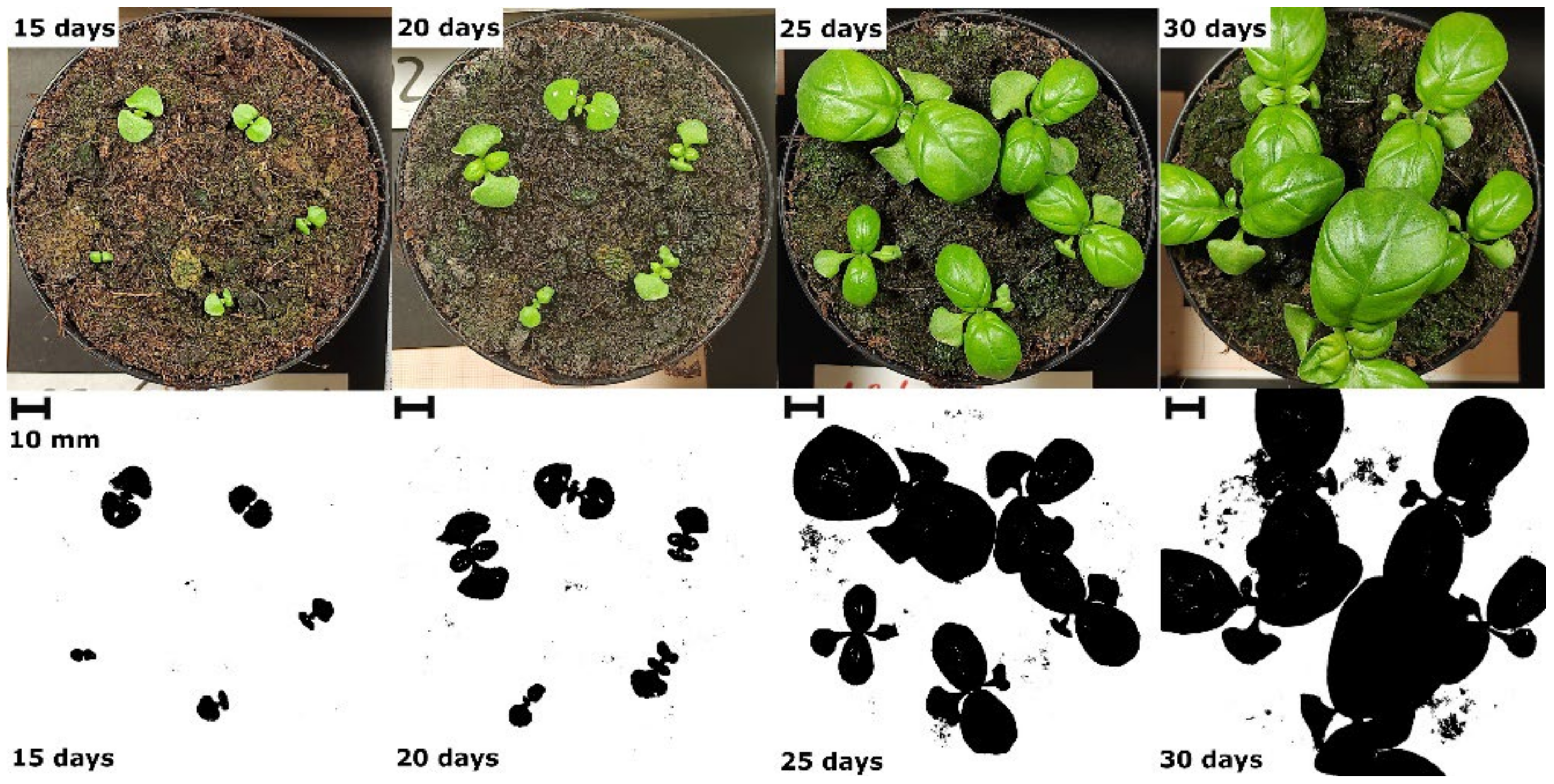
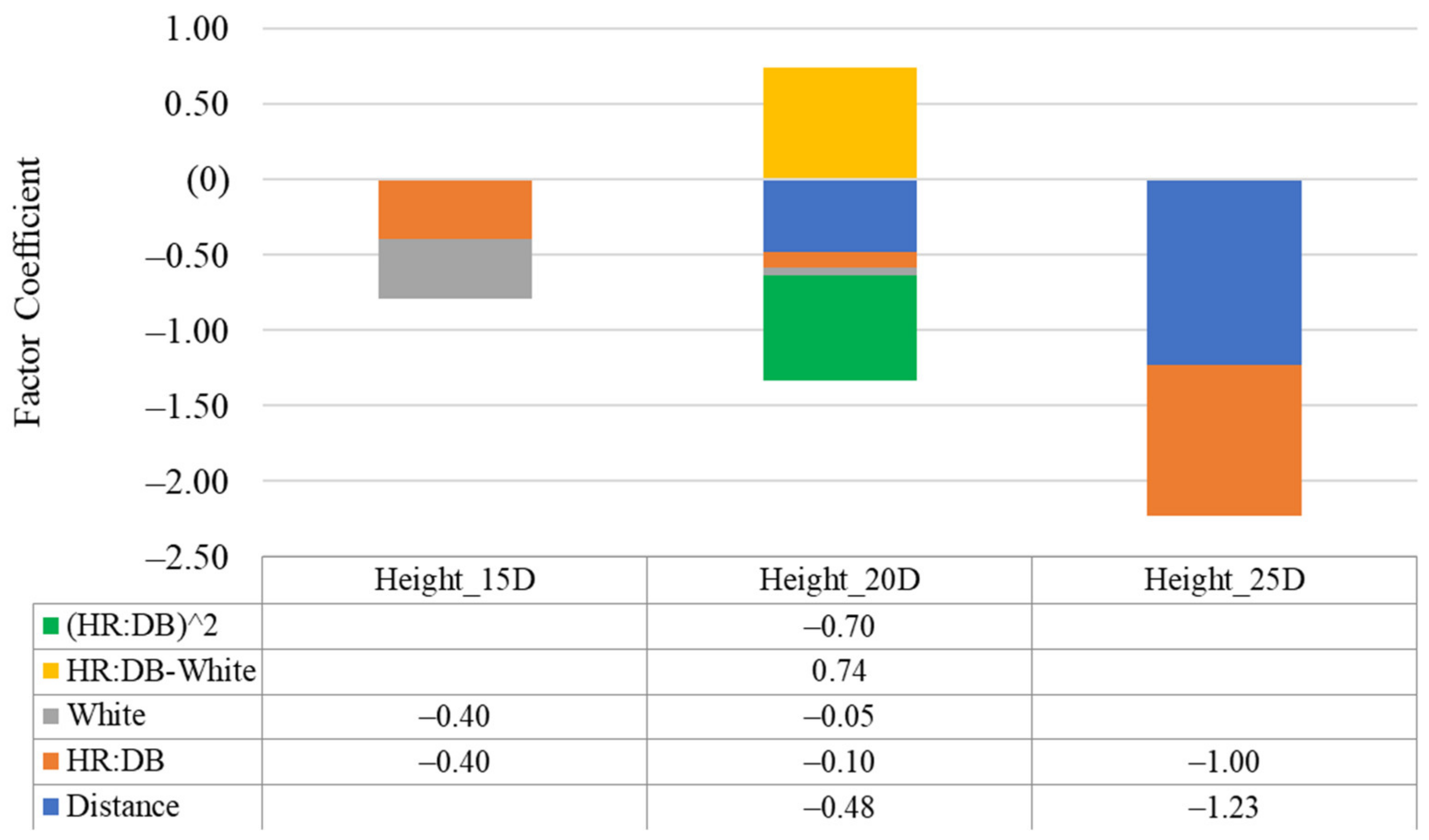
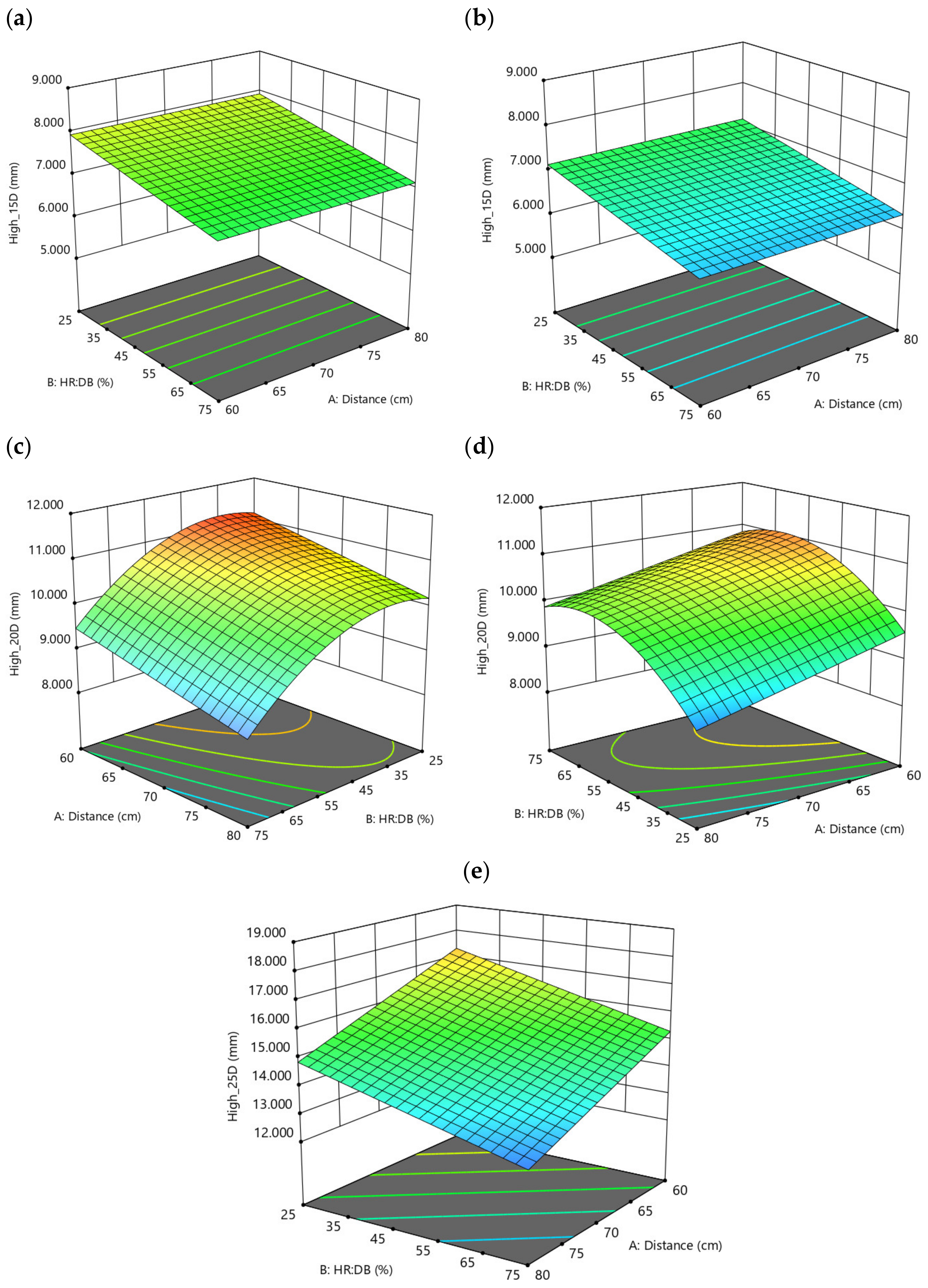
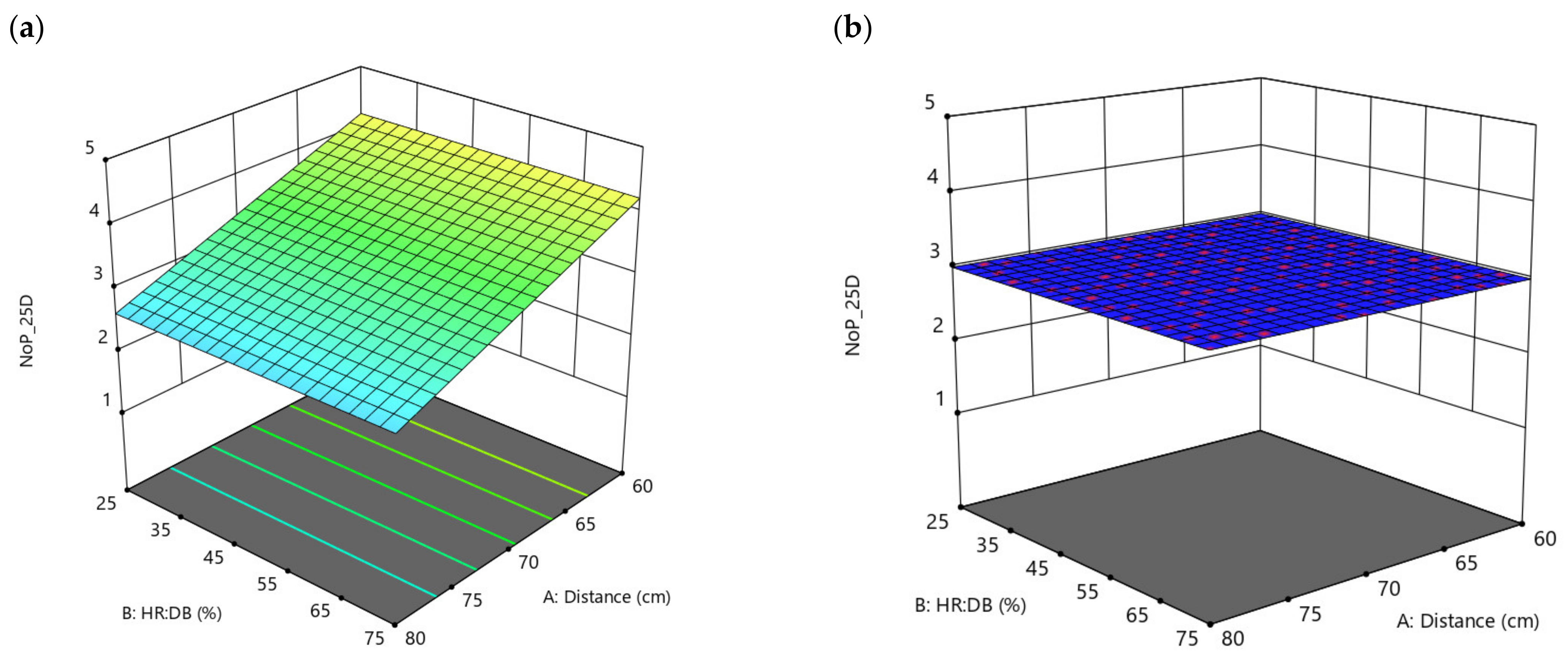
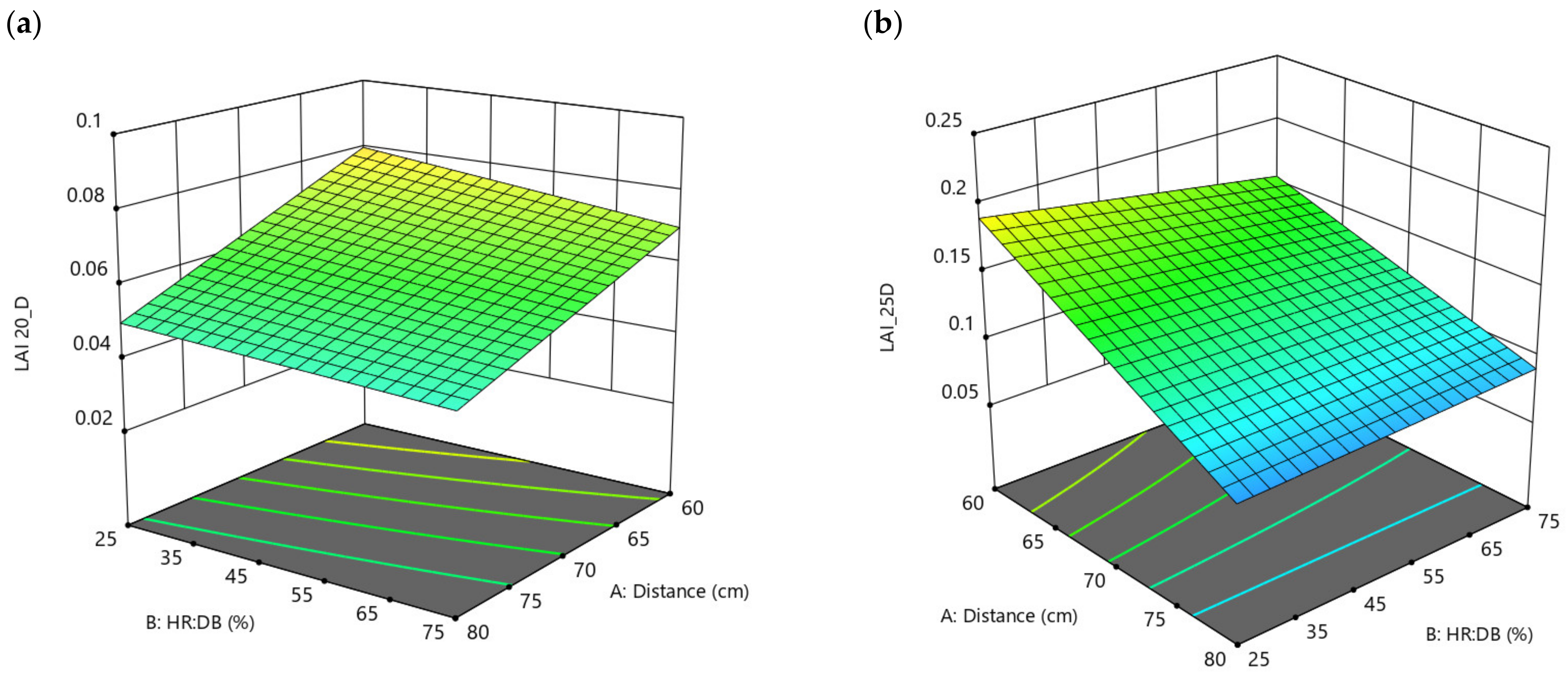
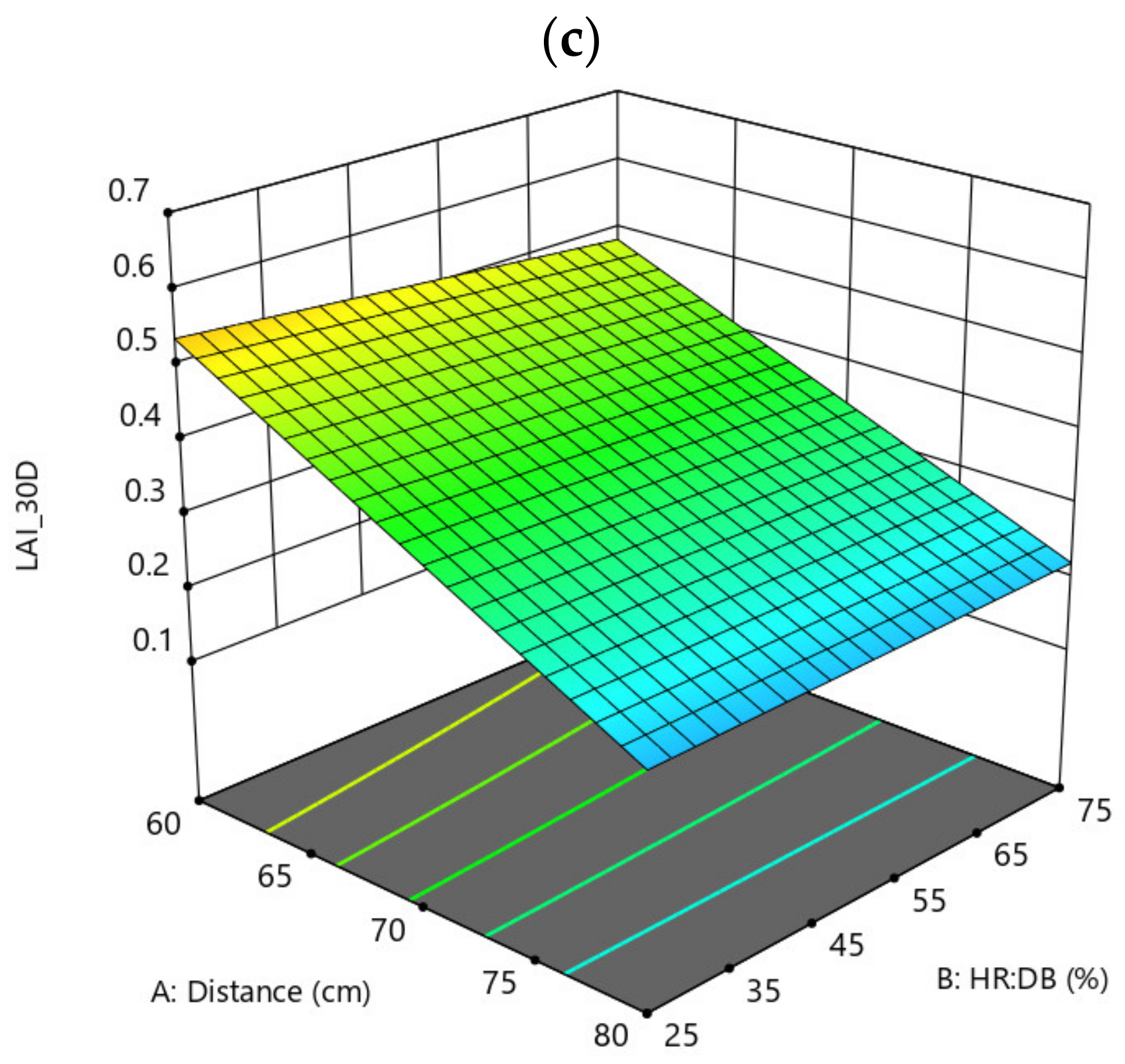
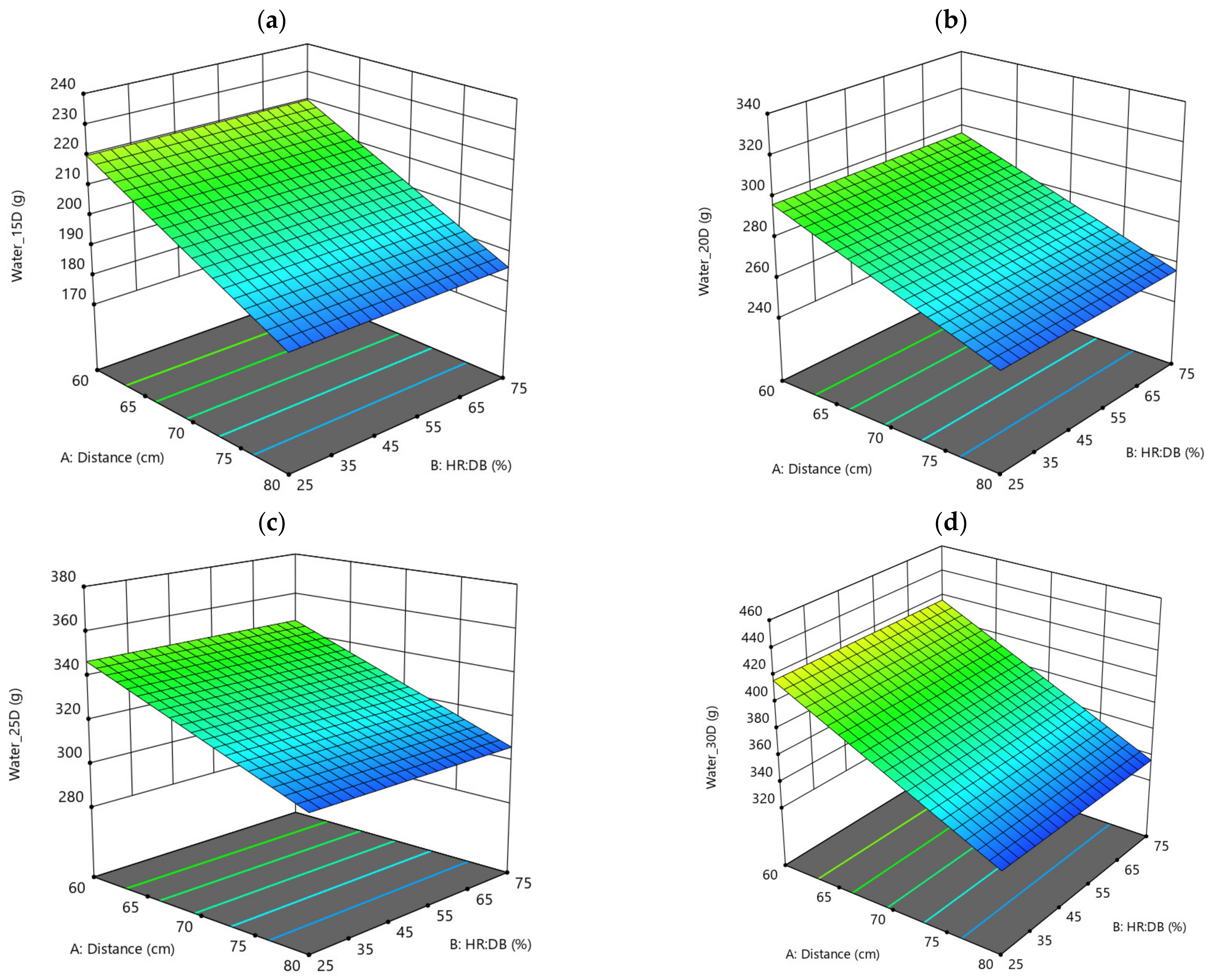
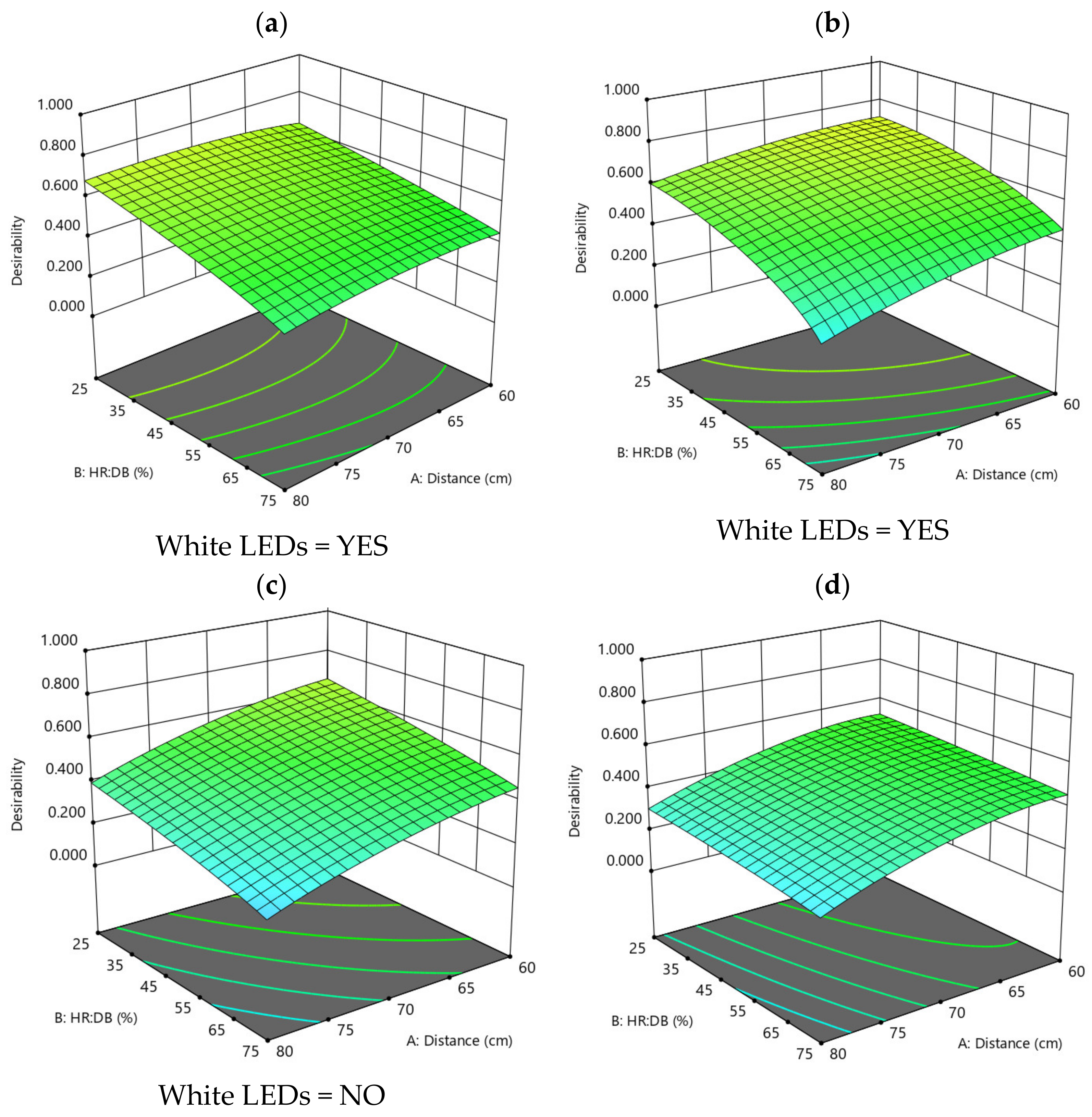
| Module Code 1 | Total Number of LEDs | Total Number of HR LEDs | Total Number of DB LEDs | Total Number of WW LEDs | Total PPF [µmol/s] |
|---|---|---|---|---|---|
| 5HR:1DB:6WW | 12 | 5 | 1 | 6 | 21.17 |
| 9HR:3DB | 12 | 9 | 3 | - | 24.91 |
| 6HR:6DB | 12 | 6 | 6 | - | 25.66 |
| 3HR:9DB | 12 | 3 | 6 | - | 26.40 |
| Combined Module’s Code 1 | PPF HR [µmol/s] | PPF DB [µmol/s] | PPF WW [µmol/s] | Total PPF [µmol/s] | %PPF HR | %PPF DB | %PPF White |
|---|---|---|---|---|---|---|---|
| 8HR 10DB 6WW | 16.11 | 22.62 | 8.84 | 47.57 | 33.87 | 47.56 | 18.58 |
| 11HR 7DB 6WW | 22.15 | 15.84 | 8.84 | 46.83 | 47.31 | 33.82 | 18.87 |
| 14HR 4DB 6WW | 28.19 | 9.05 | 8.84 | 46.08 | 61.19 | 19.64 | 19.18 |
| 12HR 12DB | 24.17 | 27.15 | 0.00 | 51.31 | 47.10 | 52.90 | 0.00 |
| 18HR 6DB | 36.25 | 13.57 | 0.00 | 49.82 | 72.76 | 27.24 | 0.00 |
| 6HR 18DB | 12.08 | 40.72 | 0.00 | 52.80 | 22.88 | 77.12 | 0.00 |
| Factor | Type | Levels | Minimum | Central Point | Maximum |
|---|---|---|---|---|---|
| Distance | Numeric/Discrete | 3 | 60 cm | 70 cm | 80 cm |
| HR:DB | Numeric/Discrete | 3 | 25% | 50% | 75% |
| White | Categoric/Nominal | 2 | YES | - | NO |
| Property | after 15 Days | after 20 Days | after 25 Days | after 30 Days |
|---|---|---|---|---|
| Height | Height_15D | Height_20D | Height_25D | Height_30D |
| Number of Plants | NoP_15D | NoP_20D | NoP_25D | NoP_30D |
| Leaf Area Index | LAI_15D | LAI_20D | LAI_25D | LAI_30D |
| Water | Water_15D | Water_20D | Water_25D | Water_30D |
| Response | Goal | Importance |
|---|---|---|
| Height | to maximize | 4 |
| Number of Plants | to maximize | 4 |
| Leaf Area Index | to maximize | 3 |
| Water | to minimize | 1 |
| Factors | Responses | ||||||||||||||||||
|---|---|---|---|---|---|---|---|---|---|---|---|---|---|---|---|---|---|---|---|
| 1 | 2 | 3 | Height (mm) | NoP | LAI | Water (g) | |||||||||||||
| Run | Distance (cm) | HR:DB | White | 15D | 20D | 25D | 30D | 15D | 20D | 25D | 30D | 15D | 20D | 25D | 30D | 15D | 20D | 25D | 30D |
| 1 | 80 | 50 | YES | 8.009 | 10.450 | 14.996 | 24.517 | 3 | 3 | 3 | 3 | 0.033 | 0.072 | 0.139 | 0.347 | 200 | 270 | 320 | 350 |
| 2 | 70 | 25 | NO | 6.935 | 9.068 | 15.538 | 21.443 | 4 | 4 | 5 | 5 | 0.028 | 0.069 | 0.131 | 0.347 | 220 | 290 | 340 | 390 |
| 3 | 70 | 50 | NO | 6.611 | 10.660 | 15.467 | 23.953 | 3 | 3 | 3 | 3 | 0.022 | 0.053 | 0.119 | 0.346 | 180 | 270 | 320 | 370 |
| 4 | 60 | 25 | YES | 7.904 | 10.176 | 14.634 | 24.586 | 4 | 4 | 5 | 5 | 0.029 | 0.073 | 0.187 | 0.532 | 220 | 290 | 340 | 410 |
| 5 | 60 | 75 | NO | 6.361 | 10.782 | 15.253 | 21.420 | 4 | 4 | 4 | 4 | 0.022 | 0.058 | 0.131 | 0.428 | 220 | 290 | 340 | 410 |
| 6 | 60 | 50 | YES | 7.595 | 11.318 | 16.968 | 24.976 | 3 | 3 | 4 | 4 | 0.031 | 0.077 | 0.182 | 0.513 | 240 | 310 | 360 | 430 |
| 7 | 80 | 75 | YES | 5.792 | 8.221 | 12.284 | 20.442 | 2 | 2 | 2 | 2 | 0.009 | 0.023 | 0.060 | 0.122 | 180 | 250 | 300 | 330 |
| 8 | 80 | 25 | NO | 6.880 | 8.691 | 13.884 | 19.888 | 3 | 3 | 3 | 3 | 0.018 | 0.051 | 0.097 | 0.239 | 200 | 270 | 320 | 350 |
| 9 | 60 | 50 | NO | 6.974 | 11.133 | 17.990 | 26.348 | 4 | 4 | 4 | 4 | 0.038 | 0.095 | 0.231 | 0.638 | 200 | 290 | 340 | 410 |
| 10 | 70 | 50 | YES | 8.819 | 9.943 | 14.902 | 21.328 | 2 | 3 | 3 | 3 | 0.016 | 0.040 | 0.074 | 0.202 | 220 | 290 | 340 | 390 |
| 11 | 70 | 75 | YES | 6.740 | 9.383 | 12.352 | 19.144 | 4 | 4 | 4 | 4 | 0.018 | 0.046 | 0.096 | 0.258 | 200 | 270 | 320 | 370 |
| 12 | 60 | 25 | NO | 6.758 | 9.588 | 17.101 | 24.102 | 3 | 3 | 3 | 3 | 0.030 | 0.072 | 0.164 | 0.489 | 240 | 330 | 380 | 450 |
| 13 | 80 | 75 | NO | 6.402 | 9.921 | 13.610 | 21.017 | 4 | 4 | 4 | 4 | 0.021 | 0.052 | 0.098 | 0.245 | 180 | 250 | 300 | 330 |
| 14 | 70 | 25 | YES | 8.457 | 11.412 | 17.987 | 24.712 | 3 | 3 | 3 | 3 | 0.035 | 0.072 | 0.131 | 0.332 | 180 | 250 | 300 | 350 |
| 15 | 80 | 25 | YES | 7.570 | 10.219 | 14.974 | 21.227 | 3 | 3 | 3 | 3 | 0.028 | 0.057 | 0.108 | 0.264 | 180 | 250 | 300 | 330 |
| 16 | 60 | 75 | YES | 7.002 | 9.300 | 13.899 | 21.593 | 3 | 4 | 4 | 4 | 0.017 | 0.043 | 0.103 | 0.348 | 220 | 290 | 340 | 410 |
| 17 | 60 | 25 | YES | 7.886 | 11.314 | 18.400 | 30.394 | 4 | 4 | 4 | 4 | 0.033 | 0.081 | 0.202 | 0.533 | 220 | 290 | 340 | 410 |
| 18 | 70 | 75 | NO | 7.389 | 10.450 | 15.792 | 23.218 | 4 | 4 | 4 | 4 | 0.027 | 0.062 | 0.122 | 0.336 | 200 | 270 | 320 | 370 |
| 19 | 80 | 50 | NO | 6.124 | 9.146 | 12.414 | 19.601 | 3 | 4 | 4 | 3 | 0.016 | 0.041 | 0.075 | 0.187 | 190 | 260 | 310 | 340 |
| 20 | 70 | 50 | NO | 7.016 | 10.640 | 15.336 | 22.134 | 3 | 4 | 4 | 4 | 0.025 | 0.062 | 0.132 | 0.388 | 180 | 270 | 320 | 370 |
| Response | p-Value Model | R2 | Pred R2 | Significant Factors | |
|---|---|---|---|---|---|
| Height | 15D | 0.0044 | 0.47 | 0.26 | HR:DB White |
| 20D | 0.0002 | 0.80 | 0.73 | Distance HR:DB White HR:DB-White (HR:DB)2 | |
| 25D | 0.0012 | 0.55 | 0.36 | Distance HR:DB | |
| 30D | 0.0096 | 0.32 | 0.14 | ||
| NoP | 15D | 0.2793 | |||
| 20D | 0.3467 | ||||
| 25D | 0.0178 | 0.46 | 0.17 | Distance White Distance-White | |
| 30D | 0.0137 | 0.29 | 0.14 | ||
| LAI | 15D | 0.0185 | 0.27 | 0.12 | |
| 20D | 0.031 | 0.49 | 0.30 | Distance HR:DB | |
| 25D | 0.003 | 0.61 | 0.48 | Distance HR:DB | |
| 30D | <0.0001 | 0.67 | 0.58 | Distance | |
| Water | 15D | 0.0005 | 0.50 | 0.41 | Distance |
| 20D | <0.0001 | 0.62 | 0.53 | Distance | |
| 25D | <0.0001 | 0.62 | 0.53 | Distance | |
| 30D | <0.0001 | 0.87 | 0.83 | Distance | |
| Height | 15_D | =8.33241 − 0.0158963 * B (If WHITE = YES) =7.53981 − 0.0158963 * B (If WHITE = NO) |
| 20_D | =12.8146 − 0.0483811 * A + 0.0777525 * B − 0.00111477 * B2 (If WHITE = YES) =9.75719 − 0.0483811 * A + 0.136848 * B − 0.00111477 * B2 (If WHITE = NO) | |
| 25_D | =25.6975 − 0.1231 * A − 0.0400614 * B | |
| 30_D | / | |
| LAI | 15_D | / |
| 20_D | =0.155884 − 0.000991378 * A − 0.00103501 * B + 6.12105 × 10−6 * AB | |
| 25_D | =0.530544 − 0.0049938 * A − 0.0040929 * B + 4.14395 × 10−5 * AB | |
| 30_D | =1.45793 − 0.0142164 * A − 0.00694369 * B + 5.99759 × 10−5 * AB | |
| NoP | 15_D | / |
| 20_D | / | |
| 25_D | =9 − 0.0797101 * A (If WHITE = YES) =3.8 – 5.55112 × 10−17 * A (If WHITE = NO) | |
| 30_D | / | |
| Water | 15_D | =325.058 – 1.74903 * A |
| 20_D | =418.378 – 2.02703 * A | |
| 25_D | =468.378 – 2.02703 * A | |
| 30_D | =658.378 – 4.02703 * A |
| 15_D | 20_D | 25_D | 30_D | ||
|---|---|---|---|---|---|
| Optimized Light | Distance (cm) | 60 | 60 | 60 | 60 |
| HR:DB (%) | 25 | 25 | 25 | -- * | |
| White | YES | YES | NO | -- * | |
| Predicted | Height (cm) | 7.93 ± 1.20 | 11.12 ± 2.12 | 17.31 ± 2. 32 | 24.34 ± 2.23 |
| LAI | 0.08 ± 0.01 | 0.18 ± 0.01 | 0.28 ± 0.01 | 0.50 ± 0.21 | |
| NoP | 3.2 ± 0.5 | 3.7 ± 0.6 | 4.2 ± 0.6 | 4.1 ± 0.5 | |
| Validation | Height (cm) | 9.37 ± 1.02 | 15.00 ± 2.54 | 20.16 ± 2.52 | 26.49 ± 2.50 |
| LAI | 0.09 ± 0.02 | 0.18 ± 0.04 | 0.23 ± 0.05 | 0.30 ± 0.07 | |
| NoP | 3.9 ± 0.7 | 4.4 ± 1.0 | 4.3 ± 1.0 | 4.3 ± 1.00 | |
| Growth Period [Days] | Combined Module’s Code 1 | PPF HR [µmol/s] | PPF DB [µmol/s] | PPF WW [µmol/s] | Total PPFLED [µmol/s] | PPFeffective 2 [µmol/s] | %PPF HR | %PPF DB | %PPF White |
|---|---|---|---|---|---|---|---|---|---|
| 0–20 | 8HR 10DB 6WW | 16.11 | 22.62 | 8.84 | 47.57 | 26.93 | 33.87 | 47.56 | 18.58 |
| 21–25 | 6HR 18DB | 36.25 | 13.57 | 0.00 | 49.82 | 28.21 | 47.31 | 33.82 | 18.87 |
| 26–30 | 18HR 6DB | 12.08 | 40.72 | 0.00 | 52.80 | 29.90 | 61.19 | 19.64 | 19.18 |
Disclaimer/Publisher’s Note: The statements, opinions and data contained in all publications are solely those of the individual author(s) and contributor(s) and not of MDPI and/or the editor(s). MDPI and/or the editor(s) disclaim responsibility for any injury to people or property resulting from any ideas, methods, instructions or products referred to in the content. |
© 2023 by the authors. Licensee MDPI, Basel, Switzerland. This article is an open access article distributed under the terms and conditions of the Creative Commons Attribution (CC BY) license (https://creativecommons.org/licenses/by/4.0/).
Share and Cite
Barbi, S.; Barbieri, F.; Taurino, C.; Bertacchini, A.; Montorsi, M. Quantitative Calculation of the Most Efficient LED Light Combinations at Specific Growth Stages for Basil Indoor Horticulture: Modeling through Design of Experiments. Appl. Sci. 2023, 13, 2004. https://doi.org/10.3390/app13032004
Barbi S, Barbieri F, Taurino C, Bertacchini A, Montorsi M. Quantitative Calculation of the Most Efficient LED Light Combinations at Specific Growth Stages for Basil Indoor Horticulture: Modeling through Design of Experiments. Applied Sciences. 2023; 13(3):2004. https://doi.org/10.3390/app13032004
Chicago/Turabian StyleBarbi, Silvia, Francesco Barbieri, Claudia Taurino, Alessandro Bertacchini, and Monia Montorsi. 2023. "Quantitative Calculation of the Most Efficient LED Light Combinations at Specific Growth Stages for Basil Indoor Horticulture: Modeling through Design of Experiments" Applied Sciences 13, no. 3: 2004. https://doi.org/10.3390/app13032004
APA StyleBarbi, S., Barbieri, F., Taurino, C., Bertacchini, A., & Montorsi, M. (2023). Quantitative Calculation of the Most Efficient LED Light Combinations at Specific Growth Stages for Basil Indoor Horticulture: Modeling through Design of Experiments. Applied Sciences, 13(3), 2004. https://doi.org/10.3390/app13032004






